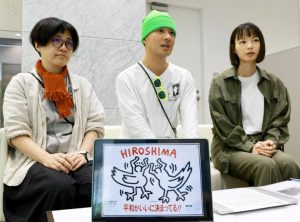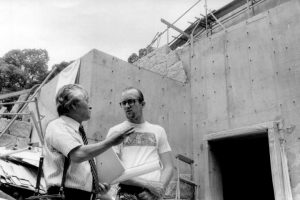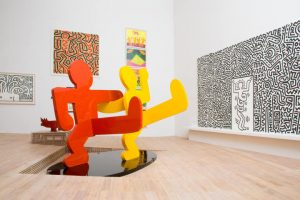Artist Keith Haring’s unfulfilled dream of creating wall mural in Hiroshima — “Tears would not stop flowing” on his visit to city in 1980s
Jan. 27, 2024
Curator team from Yamanashi seek stories and materials related to Haring’s visit
by Aya Nishimura, Staff Writer
In the 1980s, Keith Haring was a luminary on the U.S. art scene as well as an anti-nuclear, anti-war social activist. When he was 30, two years before his death, Mr. Haring visited Hiroshima with a plan to paint a wall mural in the city. If the plan had come to fruition, what would the mural have looked like? A group of three people, including a curator at the Nakamura Keith Haring Collection, located in Yamanashi Prefecture, visited Hiroshima to begin the search for stories and materials involving Mr. Haring’s visit to the city.
Starting July 28, 1988, Mr. Haring stayed in Hiroshima over a two-day period. The impetus behind his visit is considered to have been a poster he had designed for the Hiroshima Peace Concert, which was scheduled to be held in the city in August of that year.
In his journal, he wrote of his shock at seeing the exhibits at the Hiroshima Peace Memorial Museum, describing how he could not stop crying. He also explained how he came upon the idea of drawing a wall mural when he caught glimpse of Honkawa Elementary School across the river from the A-bomb Dome.
The curator and the other team members have visited Hiroshima several times since last year. The team is engaged in a survey that involves traveling to places that Mr. Haring had visited while in Hiroshima and meeting with people who have come into contact with him. Said the curator, Imako Tanaka, “We want to look into what he felt during his visit to Hiroshima and what he was hoping to leave behind in the city.” The Nakamura Keith Haring Collection is planning to hold an exhibit over the course of a one-year period based on the theme “War, peace, and freedom” starting in June this year. “We want to design the exhibit by utilizing as one of its pillars the results from the survey we’re conducting in Hiroshima.”
Mr. Haring is described as having traveled to numerous countries across the world and, when requested by people he would meet, casually creating drawings on scraps of paper and other materials. As the group gathers clues about Mr. Haring’s visit to Hiroshima, Ms. Tanaka implored, “We would like to have people come forward with any tidbit of information about seeing him in Hiroshima.”
The team plans to hold a workshop aimed at creating Mr. Haring’s unrealized mural in Hiroshima this summer. At the time of his visit in 1988, options under consideration for the mural were the Honkawa Elementary School building and inside the Hiroshima City Museum of Contemporary Art, which was under construction back then. Neither idea was achieved due to Mr. Haring’s death shortly thereafter. The group is working to recruit schools or organizations interested in collaboration. “We hope to follow his last wishes and create a large-scale drawing together with children in Hiroshima.” For further details, call the Nakamura Keith Haring Collection, at 0551-36-8712.
Profile
Keith Haring
Born in the U.S. state of Pennsylvania in 1958, Keith Haring enrolled in an art school in New York City in 1978. He first drew attention with his subway art in 1980, which he drew on subway billboards. Through his work, he called for the elimination of poverty, of discrimination against gays, and of war and nuclear weapons. He died of complications from AIDS in 1990 at the age of 31.
Keywords
The Nakamura Keith Haring Collection
The collection opened in Kobuchizawa, Hokuto City, Yamanashi Prefecture in 2007 as the only museum in the world to exclusively feature Keith Haring’s artworks. In addition to 300 of Mr. Haring’s pieces owned by the collector Kazuo Nakamura, the museum displays other items, including documentary photographs, images, and so on.
(Originally published on January 27, 2024)










